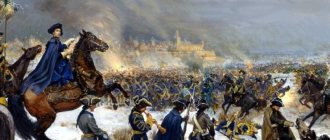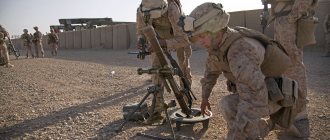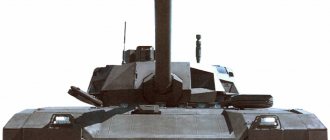By the early 1950s, the global helicopter industry was the most dynamically developing branch of the aviation industry. Having mastered the basic principles in the design of rotorcraft and mastered the complex production cycle, leading helicopter aircraft designers easily took on the development of grandiose and ambitious projects. A similar trend could be seen in the work of the American and Soviet helicopter design schools. Projects for rotorcraft for various purposes, small and medium, large and very large, began to appear overseas and in the Soviet Union.
One of the most important milestones in the history of modern aviation was the creation in the USSR of the heavy Mi 6, a multi-purpose monster helicopter. This machine could surprise even the most experienced specialist with its size and performance characteristics. The brainchild of the Mil design bureau became a real engineering and technical breakthrough, demonstrating the ability to build large aircraft in practice. In addition, the Soviet helicopter was the first in all respects. For the first time in the world, gas turbine engines were tested and installed on this model. In terms of the diameter of the main rotor, no aircraft of that time could compare with the Mi-six. In terms of the number of records set, the successes of the Soviet car still look impressive today.
How it all began?
In the Soviet Union, the 50s became a landmark period for the armed forces. Not only did military doctrine change, but tactics also underwent significant changes. New types of weapons began to be supplied to equip the troops, which in turn required improvements in army logistics. One of the main criteria for the combat effectiveness of the armed forces is the mobility of units and military equipment. Military transport aviation in this aspect became one of the components of success. However, transport aircraft, due to their performance characteristics, could not always cope with the task. The army needed a universal vehicle, which could be a heavy transport multi-purpose helicopter.
According to military experts and army leadership, the armed forces needed a transport and landing helicopter that could transport various cargo and military equipment weighing up to 6000 kg. The calculation was made on the need for rapid delivery of self-propelled and towed artillery systems, automotive equipment and other military cargo. The task was extremely difficult due to the fact that no real results in this direction had been achieved either in the USSR or abroad. However, the Soviet aircraft designer M.L. Mil and the team he led managed to cope with the task. In 1952, the outlines of a new machine, which was tentatively given the name VM-6, were already emerging on paper.
Needless to say, the development of the project started from scratch. The Mi-4 helicopter, created earlier at the Mil Design Bureau, provided the necessary engineering and technical basis for subsequent work on creating a larger and more powerful machine. Already at this stage, Mil's development became revolutionary. The designer did not use a design with two main rotors in the project, but relied on one large-diameter main rotor. To drive the huge propeller, consisting of five blades, an appropriate gearbox was required. In addition, the piston engines previously used in rotorcraft needed to be replaced with a more powerful and compact propulsion system. It was necessary to build a car for gas turbine engines. Despite the obvious difficulty in achieving the set goals, the Mil Design Bureau successfully completed the task. The Mi-6 heavy helicopter created at the design bureau became a real miracle of engineering, confirming the correctness of the chosen concept for the construction of large aircraft.
Soviet designers managed to lay the foundations for the design of heavy rotorcraft, which were later used to create new models. The propulsion system, represented by two gas turbine engines with a free turbine and a powerful gearbox, was considered an innovative development.
Achievements
At the testing stage, which the Mi-6 helicopter underwent from 1959 to 1963, it set sixteen world records, making it not only the most load-bearing helicopter, but also the fastest helicopter on the planet. The most significant achievements are considered to be lifting a load weighing 5 tons to a height of 5600 meters, lifting a load weighing 20 tons to a height of more than 2000 meters, developing a flight speed of up to 340 km/h over a section of 100 kilometers, and others. It should be noted that the last of the records mentioned remains valid today. Such achievements of the Mil design bureau did not go unnoticed - for them it was awarded the international prize named after I.I. Sikorsky.
Making a helicopter. Start of mass production
Having decided on the concept of building a heavy transport helicopter, the Mil Design Bureau began to implement the conceived ideas and developments. For the new machine in the USSR, a new turboprop engine was specially created, which was supposed to become the heart of the helicopter. The creation of engines was carried out by OKB-19 under the leadership of P.A. Solovyova. The TV-2F aircraft turboprop engine was taken as the basis.
To meet the requirements for carrying capacity, aircraft designers decided to install two gas turbine engines at once on their creation. A year and a half later, in December 1953, preliminary design documentation for the VM-6 transport helicopter was ready. The rotorcraft was designed in several versions: transport version, landing version and ambulance version. At this stage M.L. Mil managed to convince the military leadership of the feasibility of creating a future machine. The accompanying note to the preliminary design stated:
- the development was considered as a vehicle for transporting airborne units in full equipment;
- using a rotorcraft as a vehicle for transporting artillery, anti-aircraft missile systems and automotive equipment;
- the use of the machine for the transfer of various cargoes on internal and external slings weighing up to 6 tons.
The above aspects interested the military and specialists in the field of army logistics. As a result, on June 11, 1954, a Decree of the USSR Council of Ministers was issued on the start of design work on the creation of a heavy transport and landing helicopter B-6. The project was finally approved in the summer of 1955, after which the assembly of the first prototype, product 50, began. Already at this stage, they finally decided on the name of the machine, which became known as the Mi 6, thereby continuing the Mil family of helicopters. Two years later, the first flight of MI 6 took place. At that time, this helicopter became the largest and most powerful in the world. Over the course of a year, the prototype was being finalized, after which in July 1958 a high-level decision was made to begin serial production of the vehicle. The Moscow Helicopter Manufacturing Plant named after was chosen as the site for the construction of the largest helicopter in the world. Khrunicheva. In parallel with him, the Rostov Aviation Plant No. 168 was engaged in the assembly and production of the machine.
In total, during the years of serial production 1959-1980, 874 cars were manufactured in Rostov. To operate the new equipment, military transport aviation regiments were formed. The first production fifty cars - giants in 1959-62. were produced by the Moscow Helicopter Plant. The helicopter was in operation until 2004, when the last operating aircraft reached the end of their service life.
After the first production cars began to roll off the assembly line, State tests began. During 1959-63. More than 100 flights were made on production vehicles. It cannot be said that the testing of such a large machine went smoothly. During testing of production models, aviation accidents of Mi 6 helicopters occurred, the causes of which in most cases were explained by an insufficiently developed propulsion system design. Accidents arose mainly due to overload of the machine, which was caused by the desire to achieve maximum load capacity.
The most large-scale plane crashes occurred in a later period. The most memorable accidents involving the Mi 6 were the events near Novoagansk in January 1984 and the disaster in Belarus in December 1990. In both cases, during the investigation and analysis of the incident, the fact of overload of the rotorcraft was revealed.
Mi-62
Another interesting development of the Mil design bureau deserves special mention. After the Mi-28 combat helicopter appeared in service with the Russian army, it received a government order to develop the next model. The main requirement put forward for the new product is full compliance with the realities of the 21st century. Work on the project started in 2000 and lasted about ten years. Its result was that a fundamentally new helicopter was born - the Mi-62. The principle of its operation differs from similar machines produced at the beginning of this century. More specifically, the upper rotor serves exclusively for takeoff and landing, and in order for the machine to reach cruising speed, AI-222-25 jet propulsion engines are used. Each of them develops a power of 5,500 horsepower. Even despite the constant lack of financial resources, this year the vehicle was adopted by the Russian army.
Design features of a giant rotorcraft
The Mil machine was created on the basis of a single-rotor design, where the main propeller is a five-bladed rotor. The diameter of the main rotor is 30 m. In order to stabilize the vehicle in flight and to unload the main rotor, wings were installed on the fuselage. The fuselage of the rotorcraft was an all-metal semi-monocoque. The front part of the huge fuselage was occupied by the cockpit. The rest came from the spacious 80-cu.in. cargo area. meters.
In terms of the volume of the cargo hold, the helicopter could be compared with the main Soviet military transport aircraft of that time, the An-8 and An-12. Entrance to the cargo compartment was through a hatch measuring 2.65x2.7, located at the rear of the helicopter. For ease of loading and unloading, the cargo compartment was equipped with a folding ramp.
For the Mi 6, a traditional fixed landing gear design with three support legs was chosen.
The propulsion system of the rotorcraft, which was represented by two turboprop engines designed by Solovyov, deserves special attention. Serial vehicles were equipped with D-25V engines. Thanks to the enormous power of the engines and gearbox, it was possible to obtain a torque of 60 thousand kg.m. Similar systems appeared abroad only in the mid-70s. It was possible to control such a complex propeller-engine group only with the help of hydraulic boosters and cable wiring.
The vehicle was produced in various modifications, although it was more focused on the military industry. It was this modification that became the most common. 60-90 military personnel in full uniform and equipment could be transported on board the huge helicopter. In emergency cases, the number of passengers could be doubled.
In the cargo version, the rotorcraft lifted into the air a cargo weighing up to 12 tons, located inside the cargo compartment. On the external sling, the helicopter carried up to 8 tons of cargo. The practical range was 1400 km, while the useful range was 650-1000 km. This parameter was determined by the dimensions of the cargo and the take-off weight of the loaded helicopter.
Russia stretch
The crisis in Kazakhstan, I think, broke out suddenly, but not entirely unexpectedly. “When the Kazakh government decided to suspend subsidies for liquefied petroleum gas three years ago, the decision attracted little attention,” notes the Economist. “These prices doubled instantly. Protests over price increases began the next day, January 2.
“As we have seen in Egypt and Venezuela,” the American National Interest magazine reminds us of the predictability of the subsequent reaction, “when the government is left without the ability to artificially distort market prices as part of an unspoken social contract, protests become inevitable.”
And it’s worth recalling a 2022 study from the Pentagon-funded RAND Corporation called “Stretching Russia: Competing from a Superior Position.” The study, following in the footsteps of Zbigniew Brzezinski's violence belt, proposes a range of "geopolitical measures", including arming Ukraine, increasing support for rebels in Syria, regime change in Belarus and exploiting tensions in the South Caucasus. And now, it seems, the turn of measure No. 5 has come: “Reducing Russia’s influence in Central Asia.”
Help from the CSTO
In any case, the protests in Kazakhstan, which could not have been spontaneous, in just a few days turned into an armed attack on the country and its institutions; at one point the airport in the largest city of Almaty was even occupied. 16 soldiers and police were killed. Among them, two were beheaded - a method common to all those Islamist rebels who have enjoyed American support from Bosnia to Syria.
Therefore, it is almost expected that among the demands of such protests was a request for Kazakhstan to withdraw from all its alliances with Russia, from the Eurasian Economic Union, through the Shanghai Cooperation Organization in the CSTO, the CSTO.
However, Kazakh President Kassym Jomart Tokayev turned to the CSTO for help, and soon help arrived and the militants were defeated.
Summarizing information at a virtual meeting with fellow CSTO leaders on Monday, President Tokayev said the unrest had been in the works for a long time and that it all started “as if on one command.” order, destroying institutions of power. This is an attempt at a coup d'etat."
In light of this allegation, the arrest of former Chairman of the National Security Committee of Kazakhstan Karim Masimov on charges of treason is attracting additional attention. The New York Post, by the way, published a private photo in which Masimov poses in the company of current US President Joseph Biden and his son Hunter.
President Tokayev also stated that at least six waves of terrorist attacks were organized, in which up to 20 thousand members of “groups trained abroad” participated. Russian President Vladimir Putin also indicated that Kazakhstan was under attack from international terrorism; a similar assessment was made from China, whose leader Xi Jinping o. Their Belarusian colleague Alexander Lukashenko diagnosed: “What is happening in Kazakhstan is an attempt to attack post-Soviet countries close to Russia. They need to drown Russia in blood. I repeat once again - if Russia falls, it will simply overtake us. They grind us into a mill and spit us out. Therefore, we must at all costs preserve the center of our civilization, the center of our Orthodoxy.”










